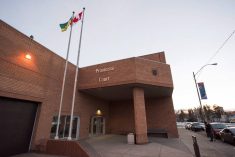Rural Alberta is better off since its school boards were merged eight
years ago, says Michele Mulder, president of the Alberta School Boards
Association.
In 1994, the province said 141 boards were too many and ordered them to
find marriage partners.
“Disgruntled acceptance” was how the boards handled the news, but most
“decided they would create their own destiny,” Mulder said. There are
now 62 boards.
Mulder said there were “have” and “have-not” boards, with the tax gap
Read Also

Vintage power on display at Saskatchewan tractor pull
At the Ag in Motion farm show held earlier this year near Langham, Sask., a vintage tractor pull event drew pretty significant crowds of show goers, who were mostly farmers.
ranging from $1,000 per student raised by the poorest, to $30,000
raised by the richest.
“We had lots of situations where there was limited ability to fund
programs because their sole tax base was agricultural.”
Ensuring a level of equity was the biggest benefit of school
regionalization, she said, because the government set a standard mill
rate, collected the tax and distributed it to the boards. Centralized
control of the taxes is another issue, she added.
Mulder is a trustee in an agricultural area covered by the Battle River
School Division. She said rural schools in that area might have faced
closures or reduced student programs without the merger. Even though
regionalization has slowed school closures, they are inevitable, she
said, because student enrolment is declining in rural Alberta.
School board mergers were more difficult in areas where people resisted
the change, she said.
In November 2001, a year after suggesting school boards should
voluntarily merge, the Manitoba government got tired of waiting. It
told its 54 school divisions that they would be merged and named their
partners. The province also said no schools could be closed until 2005.
“We’ll be 37 divisions ostensibly July 1, but no bill has been
introduced,” said Carolyn Duhamel, president of the Manitoba
Association of School Trustees.
Her association has told the province it wants clear criteria, a
process to help boards through the mergers, a reasonable time line and
financial support. But she is expecting a “controversial and difficult
experience.” At least two school areas are taking the government to
court over the forced amalgamation.
Duhamel said the public appears to accept the mergers because it
mistakenly thinks it will save money. She was a trustee for a Winnipeg
division that merged with another at a cost of $1.2 million. The saving
was only $72,000, she said.
“We amalgamated because the smaller division was losing students and
programs.”
Duhamel said she thinks the province is forcing amalgamations to move
dollars from administration into the classroom, and it is controlling
how the money is spent by reducing the voice of dissenting trustees.
“Saskatchewan is well poised to learn from other provinces how not to
do this,” Duhamel said.
Saskatchewan’s path to amalgamation began with a 1991 report to the
provincial government. The government changed and the issue was put
away until 1996, when then-education minister Pat Atkinson brought it
back.
Some voluntary amalgamations have been occurring since then, said Craig
Melvin, executive director of the Saskatchewan School Trustees
Association.
The province is allowing the process to happen voluntarily and Melvin
predicted it would be 10 years before the 99 school divisions reshape
themselves into 40 or 50. Mixing urban and rural divisions can be
complicated, he said.
“Unfortunately, in Saskatchewan we tend to create two solitudes … and
it’s really quite artificial …. Our cities are really farm support
centres.”
While farmers may worry that amalgamations will cost money, Melvin said
that hasn’t been the SSTA’s experience. For others, the issue is
keeping their connection with their kid’s school and the local
community.
“In Saskatchewan we have such a strong sense of local control. People
in Saskatchewan want the capacity to reach out and touch those in
charge.”
















